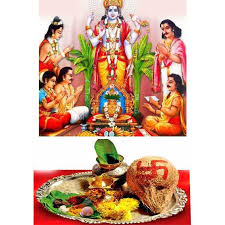The Satyanarayan Puja, a revered Hindu ritual dedicated to Lord Vishnu in his form as Satyanarayan, is performed to seek blessings, prosperity, and fulfillment of desires. This ritual is commonly conducted on auspicious occasions such as birthdays, anniversaries, housewarmings, and other significant milestones in Hindu households. Central to the successful execution of the Satyanarayan Puja is the use of specific items and ingredients known as “samagri,” each carrying profound spiritual significance and symbolizing devotion and purity.
Understanding Satyanarayan Puja:
Before delving into the details of the essential samagri required for Satyanarayan Puja, it’s crucial to understand the ritual itself. The Satyanarayan Puja typically involves the recitation of the Satyanarayan Katha, a sacred narrative that highlights the divine virtues and deeds of Lord Satyanarayan. This narrative serves as the focal point of the puja, guiding devotees on a spiritual journey of faith, devotion, and gratitude.
Essential Items in Satyanarayan Puja Samagri:
- Idol or Picture of Lord Satyanarayan: The central figure in the Satyanarayan Puja is Lord Satyanarayan himself. Devotees usually have an idol or a framed picture of Lord Satyanarayan, which serves as the focal point of worship. The idol or picture is adorned with flowers and placed in the puja area or altar, signifying the presence of the deity during the ritual.
- Murti or Picture of Lord Vishnu: As Satyanarayan is considered an incarnation of Lord Vishnu, it is customary to have a murti (idol) or picture of Lord Vishnu alongside Lord Satyanarayan during the puja. This representation emphasizes the divine connection and lineage between Lord Vishnu and Lord Satyanarayan, enhancing the spiritual significance of the ritual.
- Pooja Thali: The pooja thali (plate) is an essential component of the Satyanarayan Puja samagri. It serves as a container for various items used in the puja, such as roli (vermilion), chawal (raw rice grains), flowers, incense sticks, aarti diya (lamp), and prasad (offerings). The pooja thali is often made of metal (e.g., stainless steel, brass, or silver) and is adorned with decorative motifs, reflecting the sanctity and ceremonial nature of the puja.
- Kalash: A kalash (metal pot) filled with water, adorned with mango leaves, and topped with a coconut is a symbol of purity and auspiciousness in Hindu rituals. The kalash is an integral part of the Satyanarayan Puja samagri and represents the divine presence during the puja. The water in the kalash is sanctified and used for various rituals throughout the puja ceremony.
- Coconut: A whole coconut is offered to Lord Satyanarayan during the puja as a symbol of purity, fertility, and completeness. The coconut, placed either on the kalash or separately on the pooja thali, signifies the devotee’s reverence and devotion towards the deity, seeking blessings and divine grace.
- Fruits and Sweets: Offerings of fresh fruits (e.g., bananas, apples, oranges) and traditional sweets (e.g., peda, laddoo) are presented to Lord Satyanarayan as prasad. These offerings symbolize gratitude, devotion, and the sharing of blessings with others following the completion of the puja rituals.
- Camphor and Incense Sticks: Camphor and incense sticks are lit during the aarti (ritual of waving light) to create a serene ambiance and purify the surroundings. The fragrance of incense signifies the presence of divinity, while camphor represents the burning away of impurities and ignorance, enhancing the spiritual vibrations of the puja.
- Panchamrit: Panchamrit, a sacred mixture of five ingredients (milk, curd, honey, ghee, and sugar), is prepared and offered to Lord Satyanarayan during the puja. This mixture symbolizes purity, nourishment, and the sweetness of devotion. After offering to the deity, panchamrit is distributed as prasad among the devotees, imparting blessings and auspiciousness.
- Books or Scriptures: Books containing the Satyanarayan Katha and other relevant scriptures are essential components of the Satyanarayan Puja samagri. The Satyanarayan Katha narrates the divine tales and teachings of Lord Satyanarayan, instilling moral values and spiritual wisdom in the hearts of devotees participating in the puja ceremony.
- Coins and Dakshina: Offerings of coins and dakshina (monetary donation) are made to the priest conducting the puja and sometimes to other devotees or Brahmins present. This act of generosity and support symbolizes prosperity, gratitude, and the spirit of community among devotees participating in the Satyanarayan Puja.
- Holy Threads (Mouli or Kalava): Holy threads, known as mouli or kalava, are tied around the wrist of each participant and sometimes around the kalash or other sacred items used in the puja. These threads symbolize protection, blessings, and the sacred bond between the devotee and the deity, imparting divine grace and auspiciousness.
- Red Cloth (Chunari): A red cloth or chunari is draped over the idol or picture of Lord Satyanarayan during the puja. This cloth symbolizes devotion, purity, and reverence towards the deity, enhancing the ceremonial nature of the ritual and signifying the devotee’s heartfelt prayers and offerings.
- Roli (Kumkum) and Chawal (Rice Grains): Roli (vermilion) and chawal (raw rice grains) are used for applying tilak (religious mark) on the forehead of Lord Satyanarayan and the participants. The tilak signifies blessings, protection, and auspiciousness, invoking divine grace and divine presence during the Satyanarayan Puja ceremony.
- Dhoop and Diya: Dhoop (incense) and diya (oil lamp) are lit during the puja to create a sacred atmosphere and illuminate the puja area. The light of the diya symbolizes the presence of divine energy and spiritual enlightenment, while the fragrance of dhoop purifies the surroundings and enhances the spiritual vibrations of the puja.
Conducting the Satyanarayan Puja:
The Satyanarayan Puja begins with the purification (sankalp) of the devotees and the puja area, followed by the recitation of prayers and mantras to invoke the blessings of Lord Satyanarayan. The Satyanarayan Katha is narrated by the priest or the head of the household, detailing the divine virtues and auspicious deeds of Lord Satyanarayan.
Throughout the puja ceremony, devotees offer various items and perform rituals with devotion and reverence. The priest or the person conducting the puja guides the participants through each step, ensuring adherence to tradition and the correct pronunciation of mantras. Offerings of fruits, sweets, and panchamrit are presented to Lord Satyanarayan as prasad, symbolizing gratitude and seeking divine blessings for prosperity and well-being.
Significance of Satyanarayan Puja:
The Satyanarayan Puja holds significant spiritual and cultural importance in Hindu households, fostering unity, harmony, and familial bonds. It is believed to bestow blessings of prosperity, success, and fulfillment of desires upon the devotees and their families. The ritual reinforces the values of truth, righteousness, and devotion, as exemplified by Lord Satyanarayan, inspiring devotees to lead virtuous and spiritually fulfilling lives.
Participating in the Satyanarayan Puja cultivates a sense of reverence, gratitude, and spiritual upliftment among devotees, encouraging them to seek divine grace and guidance in all aspects of life. The puja ceremony also serves as an opportunity for communal worship, fostering a sense of community and collective devotion among participants.
Conclusion:
A complete Satyanarayan Puja samagri encompasses a diverse array of essential items and ingredients that facilitate the execution of this sacred Hindu ritual with sincerity, devotion, and adherence to tradition. Each item in the samagri holds profound spiritual significance, symbolizing purity, reverence, and the devotee’s heartfelt devotion towards Lord Satyanarayan.
By understanding the importance of these items and conducting the Satyanarayan Puja with reverence and devotion, devotees can experience spiritual fulfillment and receive divine blessings for prosperity, well-being, and spiritual enlightenment. The Satyanarayan Puja serves as a sacred journey of faith and devotion, invoking the presence and blessings of Lord Satyanarayan in the lives of devotees and their families.








